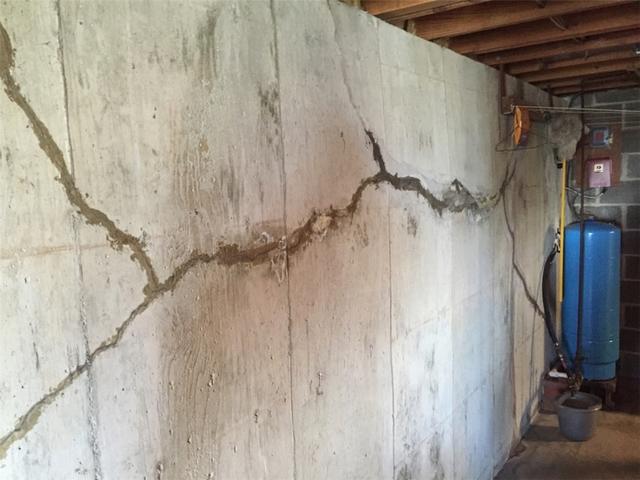A common reason for wall cracks in both new and older homes is house "settling," which can quickly and inexpensively be cured by retapping the seams between drywall panels.
As structural movements often result in large horizontal cracks, they should be addressed seriously since they can be caused by severe foundation shifting or water damage. Make sure a professional investigate these cracks.
The Causes Of Wall Cracks
Identifying the root cause is important for basement wall crack repair. Several factors, including cause cracks in walls:
- Subsidence: As a result of collapsed foundations, a building sinks to the ground.
- Settlement: During settling, hairline cracks may appear over doors and windows. It is inevitable for a wall to crack in the weakest part over time in a house of any age.
- Reactive soil: Changing moisture content causes soil to react in a specific way. Because clay-based soils can shift with changes in moisture content, they are often called 'reactive soils' due to their ability to adjust volume and structure dramatically. This ability to change volume and shape defines how 'reactive' soil is. When designing your house's footings, you need to ensure they are designed to protect it from soil movements that may otherwise cause your house to sink or buckle.
- Climate and Seasonal changes: Climate changes affect soil moisture, evaporation rates, river flows, lake levels, and snow cover.
- Digging and construction: This can include excessive water content, inadequate placement or compaction, inadequate cover for reinforcement, incorrect placement of steel, and poor curing due to poor workmanship and insufficient quality control.
- Water Damage: Cracks on foundation and basement walls are commonly caused by increased hydrostatic pressure. Water soaks into the foundation's soil, increasing its weight and exerting more pressure on its walls. Walls can bow and crack as a result.
- Trees: The growth and movement of roots alter soil conditions, leading to cracks in concrete structures buried in soil around trees.
- Degradation of building materials: In concrete, deterioration occurs when several aggressive agents penetrate and cause cracks to appear.
How to Repair Cracks in the Basement Wall
Water, droughts, flooding, unprepared soil, overgrown trees around the house, freeze-thaws, poor construction, and soil changes can all lead to cracks and foundation problems. Wall cracks can allow moisture and humidity into your living space, causing mold to grow and unhealthy air to circulate. Flooding can occur in basements and crawl spaces during heavy rains, leading to expensive repairs, furniture, appliances, floors being damaged, and heirlooms being ruined.
Although most cracks in your home are not indicative of a structural issue, you should be aware of any other signs of foundation problems. It is important to hire a professional to assess the severity of wall cracks, as cracks up to 25mm wide can indicate structural damage. However, cracks with a width greater than 25 mm indicate significant structural damage, which requires cutting and reconstruction. In contrast, smaller cracks in the concrete beneath the house usually result from seasonal expansion and contraction of the clay.
Process of Repairing Basement Wall Crack:
The best way to repair basement wall cracks is to use a caulking gun and epoxy. The end of the epoxy pipe can be used in the crack to seal it. Depending on the crack's severity, some basement wall crack repairs require regular filling, while others require a specialist's advice.
For basement wall crack repair, urethane sealants can be applied. Furthermore, it prevents cracks and erosion by preventing water from entering the foundation. A half-hour is all it takes.
Concrete cracks need to be sealed with cement plaster to prevent further damage. Cracks smaller than 1/4 inch can be filled with concrete or liquid putty. It is also favored for waterproofing substrates because polyurethane remains flexible after curing, so that small movements do not reopen cracks.
A wide crack in the basement walls might indicate serious structural problems with the foundation. Fillers and sealants can be used to repair them. A narrow and relatively short crack in the wall will not be structurally significant, but it will enable water to penetrate the building. Since polyurethane remains flexible after hardening, it prevents subfloor movement from reopening cracks in basements. The homeowner will still need to hire a basement waterproofing company that offers advice and repair services to repair cracks in the basement wall.
Insurance Claim for Basement Wall Crack Repair
Various factors, such as moisture, natural settlement, sagging ceilings, etc., can cause a wall to crack. A hairline crack less than 2 millimeters in diameter is generally harmless. Because cracked walls are usually caused by the expansion and contraction of clay under your home over time, home insurance typically does not cover cracks in basement walls, nor does it repair them.
Conclusion:
Hence, it is crucial to evaluate the crack's cause and assess the crack type to determine the best solution before you repair it. Always use the best quality product for repair, and never neglect hairline cracks as they will get worse and won't even get covered by insurance companies.





